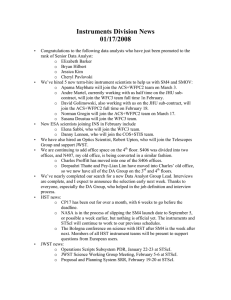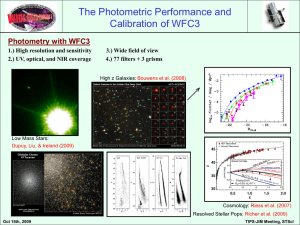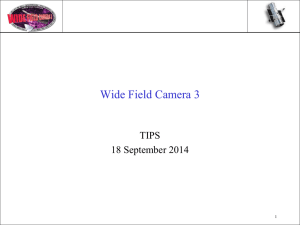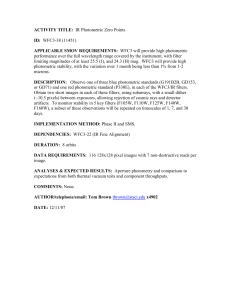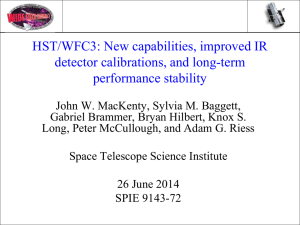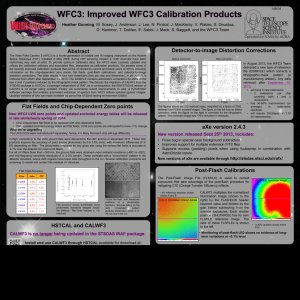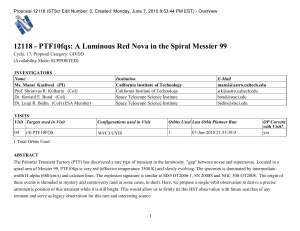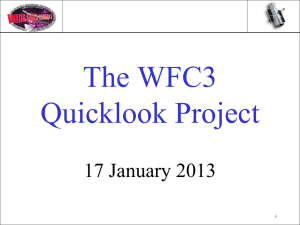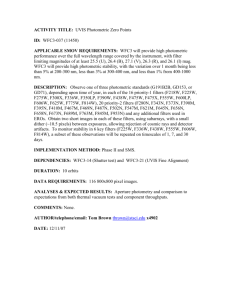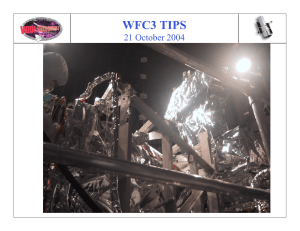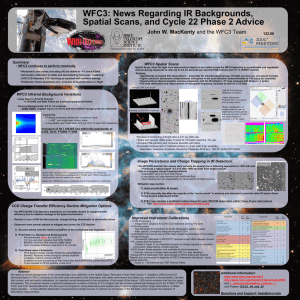Status and Calibration of the HST Wide Field Camera 3
advertisement
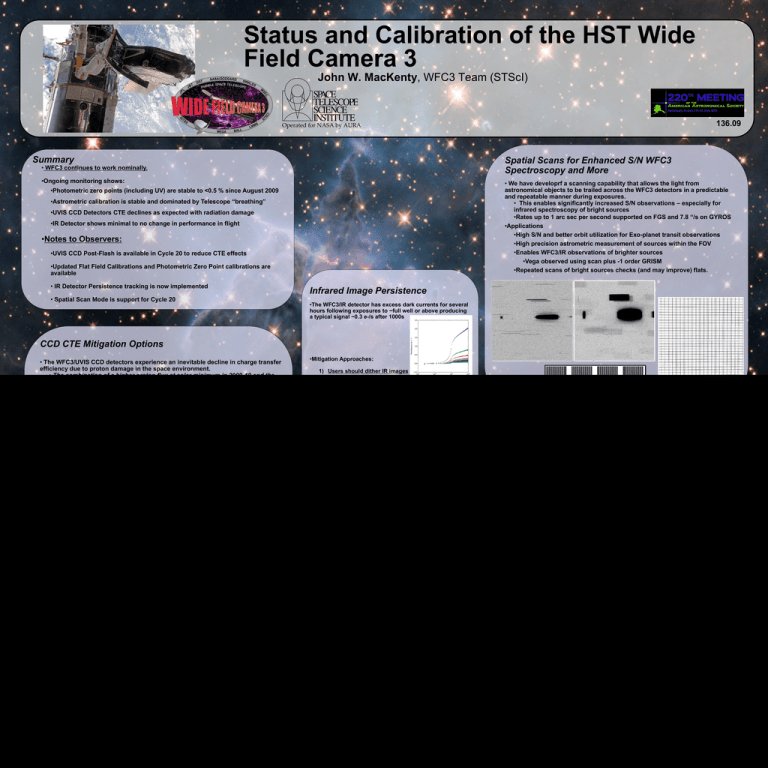
Status and Calibration of the HST Wide Field Camera 3 John W. MacKenty, WFC3 Team (STScI) 136.09 Summary Spatial Scans for Enhanced S/N WFC3 Spectroscopy and More • WFC3 continues to work nominally. •Ongoing monitoring shows: • We have developrf a scanning capability that allows the light from astronomical objects to be trailed across the WFC3 detectors in a predictable and repeatable manner during exposures. • This enables significantly increased S/N observations – especially for infrared spectroscopy of bright sources •Rates up to 1 arc sec per second supported on FGS and 7.8 “/s on GYROS •Applications •High S/N and better orbit utilization for Exo-planet transit observations •High precision astrometric measurement of sources within the FOV •Enables WFC3/IR observations of brighter sources •Vega observed using scan plus -1 order GRISM •Repeated scans of bright sources checks (and may improve) flats. •Photometric zero points (including UV) are stable to <0.5 % since August 2009 •Astrometric calibration is stable and dominated by Telescope “breathing” •UVIS CCD Detectors CTE declines as expected with radiation damage •IR Detector shows minimal to no change in performance in flight •Notes to Observers: •UVIS CCD Post-Flash is available in Cycle 20 to reduce CTE effects •Updated Flat Field Calibrations and Photometric Zero Point calibrations are available • IR Detector Persistence tracking is now implemented • Spatial Scan Mode is support for Cycle 20 Infrared Image Persistence •The WFC3/IR detector has excess dark currents for several hours following exposures to ~full well or above producing a typical signal ~0.3 e-/s after 1000s CCD CTE Mitigation Options • The WFC3/UVIS CCD detectors experience an inevitable decline in charge transfer efficiency due to proton damage in the space environment. • The combination of a higher proton flux at solar minimum in 2009-10 and the lower readout noise of the CCDs compared to prior HST instruments results in a significant (and increasing) loss of signal for faint sources • Observers have several options to mitigate and correct for this effect: 1) Sources placed near the readout amplifiers in the corners are less impacted. 2) Correction algorithms: • Stellar Photometry empirical corrections (appropriate to sparse fields) • Pixel-based correction (Anderson-Bedin) – see Poster: 136.10 • Now available in ACS pipeline (WFC3 during Cycle 20) • Does not recover S/N – returns charge to it proper place 3) Charge Injection (available starting in Cycle 19) • WFC3 can inject 17,000e- into every 10th or 17th row • Creates complex calibration issues • Mitigation is function of distance from injected row, source distribution/brightness, and background • Suitable for only a very limited subset of observations 4) Post-Flash (i.e. Background Enhancement) • Recommended option for Cycle 20 observers • Key Observation: 10-15 e- per pixel restores nearly all CTE • Observers should calculate expected backgrounds from sky & sources in the field (function of filter and exposure time) plus dark, then add N e• Price: increased noise level • e.g. zero background UV observation: 3e- readnoise plus 12 e- postflash is equivalent to 4.6e- readnoise detector • White Paper on Recommended Strategy for CTE Mitigation to be released by 6/29 Central 1000x1000 pixel region of 360s darks exposures •Mitigation Approaches: 1) Users should dither IR images 2) STScI manually identifies a subset of the “worst events” in advance and generally precludes other IR observations during several subsequent orbits 3) STScI now provides a predicted residual image for every WFC3/IR observation http://archive.stsci.edu/predps/persist/search.php Improved Calibrations • Flat Fields •New UVIS flats correcting for ~5% low spatial frequency residuals installed Dec 2011 •Based on Omega Cen observations in 10 broad band filters (F225W-F814W) •Corrected for internal “Flare” feature from detector assembly •Residual errors 1-2% peak-to-peak (except <300nm where work remains) •Updated IR flats were installed Dec 2010 based upon stacked sky flats •Ongoing improvements including compensation for “blobs” • •Photometric Zero Points •All UVIS and IR photometric observations re-analyzed with new flats •Results at http://www.stsci.edu/hst/wfc3/phot_zp_lbn (March 2012) •Most filters have ~1-2% scatter using 4 HST calibrators •Change: all filters directly measured (removed interpolation to smoothed QE curve) • But pay attention to “breathing of the telescope. This has a strong impact on small aperture photometry. •Astrometric Calibration •Based upon multiple observations of Omega Cen •Very stable since SM4 •UVIS: F225W, F275W, F336W, F390W, F438W, F475W, F555W, F606W, F350LP, F775W, F814W, F850LP •IR: F098M, F105W, F110W, F125W, F139M, F140W, F160W, F153M (added Cy19) Zero e- Post-Flash 15 e- Post-Flash •Spectroscopic Mode (GRISM) Calibration • www resource http://www.stsci.edu/hst/wfc3/analysis/grism_obs/wfc3-grismresources.html#Proposal_Documentation__Information_hdr For further information: Abstract The Hubble Space Telescope's Wide Field Camera 3 continues to perform at or better than its specifications. The team at STScI provides both user support and instrument calibration with several major improvements in calibration over the past year. This poster describes: (1) our continuing analysis and recommendations for mitigation of changes in the CTE of the CCD detectors, (2) improvements to key calibrations for detector flat fields, photometric zero points, and slitless spectroscopic modes, (3) the availability of pixel history tracking to support identification and partial correction of image persistence in infrared images, and (4) results from our initial investigations of using spatial scan mode to enhance differential photometry and astrometry of bright sources. http://www.stsci.edu/hst/wfc3 and http://www.stsci.edu/hst/wfc3/documents/ISRs

